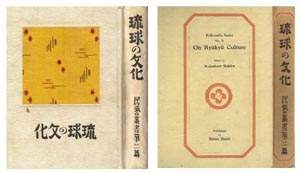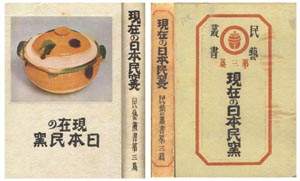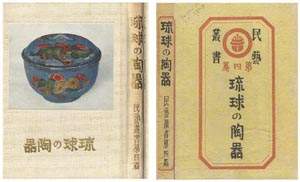|
~ Folk-Crafts Series, No. II
On Ryukyu Culture ~
Edited by Ryuzaburo Shikiba

Ryuzaburo Shikiba (editor):
Folk-crafts Series, No. II, On Ryukyu Culture, Tokyo, Showa Shobo, Nippon Folk-crafts Society, 1941, 12mo (5 1/2 x 7 1/2 in - 13.7 x 18.6 cm), English language (pages 1-40 - reading front to back), Japanese language (pages 1-304 - reading back to front), 20 pages of halftone photograph reproductions (39 different images) at the front of the Japanese section, paper covered boards with paste on halftone color illustration, black lettering on boards and spine, cardboard slip case, 344 pages total (Japanese and English sections). One (No. II) in a series of books on Japanese folk-crafts including those in the Ryukyu Islands.
The photographic images in this book are of particular interest as in a few year, most of the historic/cultural sites and assets pictured would be destroyed or severely damaged in during the battle of Okinawa.
Specific Headings/Topics Addressed in English Portion:
- Tombs
- Shuri
- Architecture
- Ryukyu Language
- Poetry
- Music
- Dancing
- Costume
- Dye-Work (extensive section)
- Earthenware
- Textile
This is a part of a series of books on Japanese folk crafts which include Ryukyuan folk crafts.
Folk-craft Series, Nippon Folk-crafts Society, Tokyo (more information, below
No. I. Mingei-towa Nanika (Nature of Folk-Crafts), 1941
No. II. Ryukyu Culture (English & Japanese languages), 1941
No. III. Genzai no Nihon Min-yo (Private Kilns of Modern Japan) (Japanese language only) not specific to Ryukyu, 1942
No. IV. Ryukyu no Toki (Ceramics of the Ryukyu Islands), (Japanese language only) 1942
I have seen the book cover designs of Nos. II, III and IV, above, attributed to Keisuke Serizawa, the noted Japanese kata-zome (stencil dye) artist. The three all have similar paper covered boards. I can not confirm Serizawa's role in the books however. Serizawa did execute many book covers and jackets and his involvement in this folk-craft series is logical. He was deeply involved in the Mingei (Folk Craft) movement in Japan at this time. That movement was founded in the 1920s by Yanagi Soetsu. It is also noted that around 1940 Serizawa returned from his second visit to Okinawa. In 1939 he made is first visit to Okinawa with Yanagi Soetsu. At least two of the books are related to Okinawan folk art.
Title Page (English)

Slip Case

Illustrations:
"Kasuri" A Textile (Cover)
- Shuri Castle
- Benzaiten Hall, Shuri

- Sogenji, The National Temple
- Engakuji Temple, Shuri
- A Stone Gate, Engakuji Temple
- A Residence, Naha

- The Main Gate
- Prince Sho Residence
- Shikinaen Park
- A Little Stone Bridge, Shikinaen

- The Mausoleum Yard, Prince Sho Family
- Tamaudun, The Mausoleum, Prince Sho Family
- A Tomb
- A Cemetery, Naha

- Sonohiyamdake, A Sanctuary
- Village Shrines, Tsuboya
- A Gate Yard
- A Peasant House

- Shuri Park
- Shuri Park
- An Old Stone Gate, Shuri
- An Old Well

- A Tiled Roof
- Tiled Roofs
- A Sculpture

- A Stone Carving
- A Stone Carving
- A Plastic Carving
- A Plastic Carving

- A Bas-relief, Yomochi Bridge, Shuri
- A Stone Bridge, Engakuji Temple
- A Stone Lantern
- A Stone Lantern

- Pottery Making, Tsuboya
- Pottery Drawing, Tsuboya
- Spinning, Shuri
- Furoshiki Making, Naha

- Miyagusuku Seiju, The Best Living Actor.
- Actors

Colophon:

Showa 16 (1941)
Nippon Folk-crafts Society
Folk-crafts Series, Nos. II-IV
1942 - Ryukyu Culture, Folk Crafts Series, No. II

Available - Purchase Here
Ryuzaburo Shikiba (editor):
Folk-crafts Series, No. II, On Ryukyu Culture (Ryukyu no Bunka), Tokyo, Showa Shobo, Nippon Folk-crafts Society, 1941, 12mo (5 1/2 x 7 1/2 in - 13.7 x 18.6 cm), English language (pages 1-40 - reading front to back), Japanese language (pages 1-304 - reading back to front), 20 pages of halftone photograph reproductions (39 different images) at the front of the Japanese section, paper covered boards with paste on color illustration, black lettering on boards and spine, cardboard slip case, 344 pages total (Japanese and English sections). One (No. II) in a series of books on Japanese folk-crafts including those in the Ryukyu Islands. For more information on this book, click here.
1942 - Genzai No Nihon Min-yo (Private Kilns of Modern Japan)
Folk-crafts Series, No. III

Available - Purchase Here
Yanagi Soetsu
Ryuzaburo Shikiba:
Genzai no Nihon Min-yo (Private Kilns of Modern Japan), Folk-crafts Series, No. III, Tokyo, Showa Shobo, Nippon Folk-crafts Society, 1942, 12mo (5 1/2 x 7 1/2 in - 13.7 x 18.6 cm), Japanese language, 9 pages of halftone photograph reproductions (36 different images) at the front, foldout map at the rear, paper covered boards with paste on halftone color illustration, black lettering on boards and spine, cardboard slip case, 292 pp. The foldout map (2 folds out, 1 fold up) is black and white. It depicts Japan with an insert showing Okinawa. Forty-five kilns are marked on the map and identified in the accompanying legend. The first kilm is on Okinawa. Book design by Keisuke Serizawa? One (No. III) in a series of books on Japanese folk-crafts including those in the Ryukyu Islands. For more information on this book, click here.
1942 - Ryukyu no Toki (Ryukyu Ceramics) - Folk-crafts Series, No. IV

Available - Purchase Here
Yanagi Soetsu (editor):
Ryukyu no Toki (Ceramics of the Ryukyu Islands), Tokyo, Showa Shobo, Nippon Folk-crafts Society, 1942, 12mo (5 1/2 x 7 1/2 in - 13.7 x 18.6 cm), Japanese language, 14 halftone plates (1 in color) at the front, cloth boards with paste on halftone color illustration, gilt lettering on front board and spine, cardboard slip case, 234 pp. Book design by Keisuke Serizawa? One (No. IV) in a series of books on the folk crafts of Japan, including the Ryukyu Islands. To see the covers, colophon and a sample plate, click here.
|

















